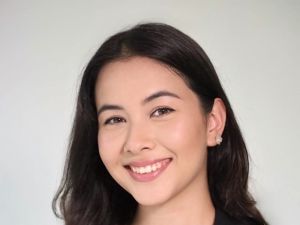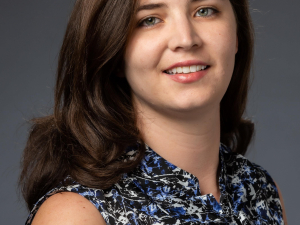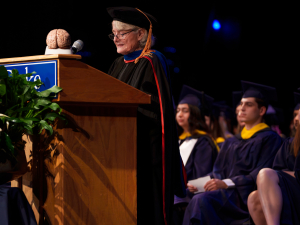Faculty members Bridgette Hard and Sarah Gaither share teaching approaches for fall semester
Compelled by the pandemic to approach teaching in new and creative ways, Duke faculty members — including P&N's Bridgette Hard and Sarah Gaither — share ways they've prepared for the start of the fall semester.
Published in Duke Today, August 14, 2020 by Eric Ferreri
This fall semester, Duke Kunshan University lecturer Ashton Merck will be communicating with her students more than usual.
She plans to check in with her students early and often through WeChat messages, email, and virtual office hours. Merck hopes that by staying in contact, students will feel more connected to the course and to each other, no matter where they are in the world.
“I think that especially in this stressful time, instructors have a responsibility to open up lines of communication that students feel comfortable using for personal as well as professional matters,” said Merck, a visiting lecturer and DKU Global Fellow who will teach courses in regulation and public policy this fall. “That could mean different things for different professors and class sizes: normalizing less formal emails, opening up new platforms for ad hoc communication like Microsoft Teams, or even providing an emergency contact number.”
Merck is one of scores of departments, schools and individual faculty members who, as the fall semester begins today, are forced by the pandemic to approaching teaching in new and creative ways.
Here’s what others are doing:
LAW
Lisa Kern Griffin, the Candace M. Carroll and Leonard B. Simon Professor of Law, began to think about how to adapt her favorite course, Evidence, once the Law School decided to move the majority of its fall semester classes online.
Evidence is a large lecture that surveys a great deal of material, but she has always enjoyed getting to know students as individuals and tried to ensure regular exchanges with everyone in class. To do that online, she has divided the class into two sections, six discussion groups, and 12 panels, and hopes that some “creative scheduling” will enable her to engage with each students and give them a chance to connect with each other, too.
“I am finding that there are some advantages to the online world,” Griffin said. “We can invite speakers and bring new voices into the class discussion with ease, and we have a lot of options for scheduling meetings with students outside of the classroom.”
PUBLIC POLICY
Kristin A. Goss has completely overhauled one of her undergraduate classes for the online environment. Goss will provide students with real-world, real-time experiences to delve into the theories and principles of politics and policy and explore civic virtues - during the election season and a global pandemic.
“Crises provide opportunities, and I’ve used the COVID-19 crisis to radically rethink my introductory course in American politics,” said Goss, a professor of public policy and political science and director of the Duke in DC program. “We’re going to spend our time in small learning communities building our skills as virtuous, informed and effective participants in public life.”
Goss transformed her 301 PubPol class from a large lecture course into three, smaller seminars that will meet twice a week, with a time set aside for guest speakers, writing workshops or other reasons. She replaced exams with ethical reflections and a portfolio of professional “deliverables,” while implementing mastery-based assessment in lieu of traditional grading protocols. The core assignments will be a set of deliverables for an actual lawmaker via Policy Lab; students will also write a “class constitution” to structure the learning experience.
“I’m working to do everything possible to create a culture of trust, support, moral reflection, deep learning and skills building with this reimagined course,” she said. “I hope that by semester’s end, students will feel like they have been a part of an intellectually exciting and personally nourishing learning community.”
POLITICAL SCIENCE
Michael Munger, professor of political science and director of undergraduate education in the department, had already been putting some equipment together for making videos on his YouTube channel.
Then he was asked to do some videos for a university in Ecuador, so he added a wooden podium, a projection screen and other equipment.
“The advantage of that setup is that I can now give video lectures, the lecture I would normally give in class, and assign THAT lecture to the students as ‘pre-class preparation,’ Munger says. “This is standard for the flipped-classroom approach, so there is nothing novel there. The advantage for the particular situation of this fall is that I can run discussions in hybrid settings.”

Facilities reconfigured classrooms to meet social distancing standards.
A “breakout room” feature in Zoom will allow students in the in-person class to mix with the remote but synchronous watchers seamlessly, adds Munger, also a professor of economics and public policy.
“I think the major advantage is that it will line up the experiences of the in-class, and remote, students much more fairly, since much of their experience will be the same,” he says.
NURSING
Among the many adjustments made by the School of Nursing in order to welcome students to campus for the summer and fall semesters was to ensure appropriate social distancing within DUSON’s Center for Nursing Discovery clinical simulation labs. Floor decals are used identify where students can stand when participating in simulation scenarios as well as desk decals for maintaining appropriate spacing for clinical instructional seating.
In addition, because of the number of students and faculty using the simulation labs, increased cleaning and maintenance protocols were developed and increased symptom testing screening checks were implemented.
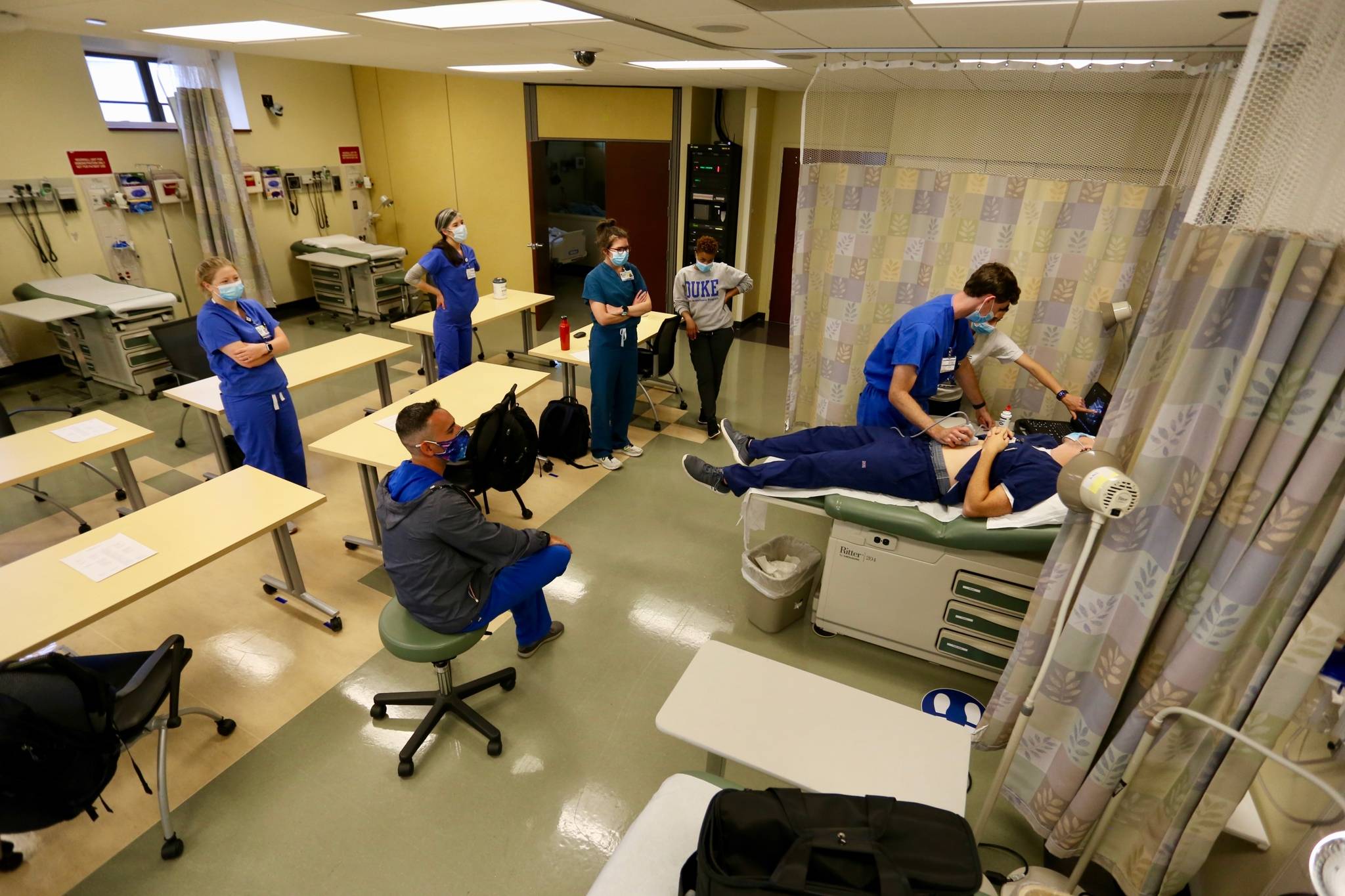
Duke nursing students with masks on.
ECONOMICS
When professor and co-director of the M.S. Economics & Computation program Charles Becker realized virtual learning was in store for the fall semester, his first thought was community building. Although students can’t meet in person, Becker knew that their seeing each other face-to-face was important, so he set up weekly Zoom calls to build community and get to know new students. Becker hosts the calls at 11:00 p.m., to make sure international students in other time zones are accommodated.
Becker also set up an alumni mentoring team where current students are matched with alums, of whom they can ask questions as well as make connections. Meanwhile, a student initiated a chat room where second-year students can answer questions from the first-year students and show those new students the ropes. Becker hopes that these informal interactions will help new students feel more “at home” at Duke, even if they’re not in Durham.
His advice to other faculty and program directors? Answer emails quickly, check up on people, and Zoom a lot. “There isn't a single magic bullet, but repeated contact is critical,” he said.
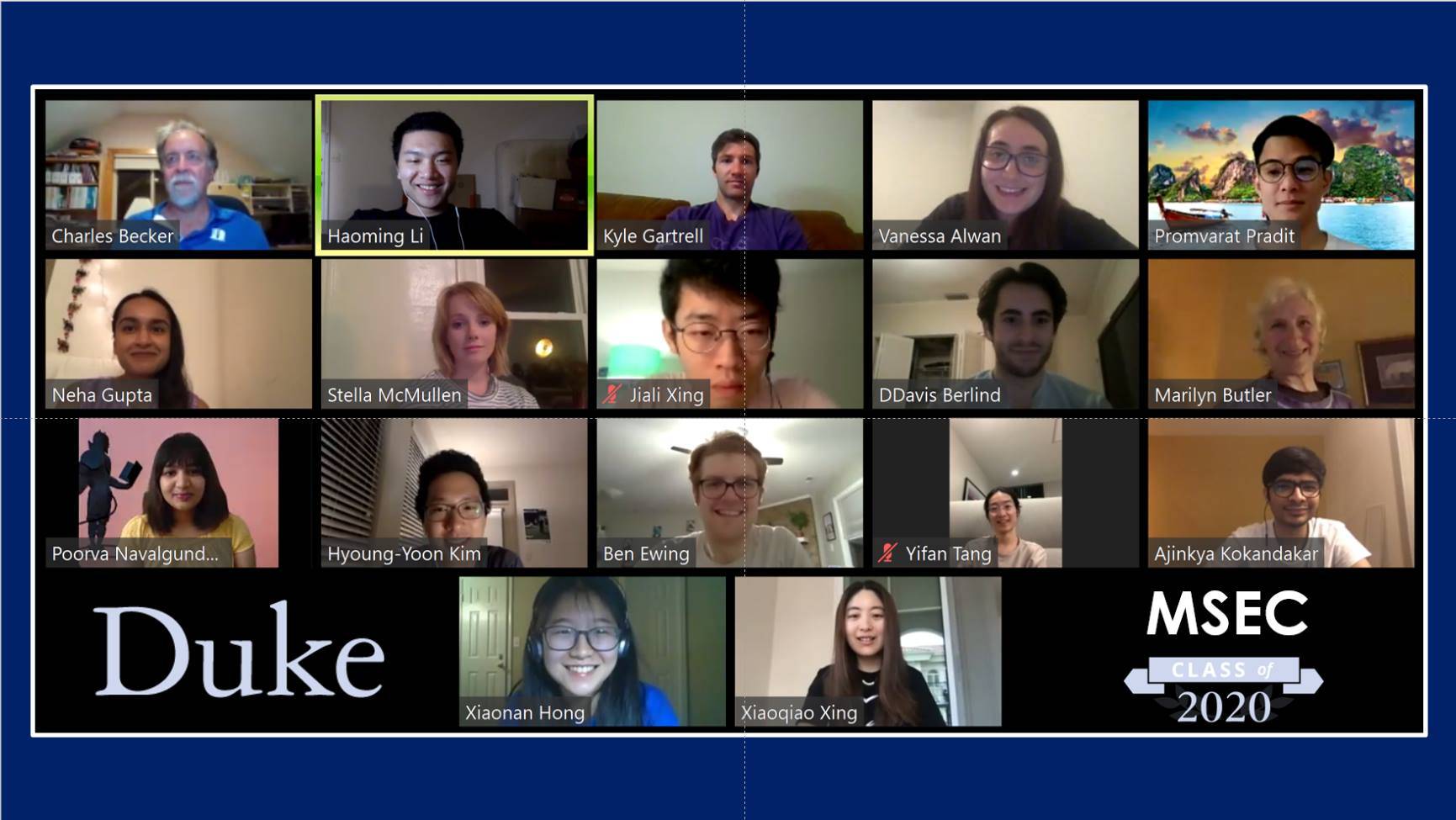
A Zoom session with professor Charles Becker's class.
GERMAN STUDIES
Language classes faced particular challenges in the COVID teaching and learning environment because, as German Studies Professor and Chair Stefani Engelstein explained, “you need to put people in small groups (to converse) and yet still hear them to correct pronunciation, grammar…whether they have perhaps drifted into English.” While Zoom breakout rooms allowed for those groups, there wasn’t enough personnel in such a small department to staff each class section with multiple instructors.
So, lecturing fellow Susanne Freytag piloted some clever new techniques while teaching summer courses over the last few months. One is an enhanced breakout room model where student groups simultaneously work on a Google doc – so anyone with the right permissions can see the contributions and edits happening in real time. “(Instructors) can see when work on the Google doc stops and then know to step into the breakout room to help.”
Freytag and fellow lecturing fellow April Henry have also designesd ways to make use of emerging and established technologies helped on many fronts: Students recorded videos of themselves speaking in German via FlipGrid, allowing one-on-one attention and individualized instruction. They incorporated Kahoot! team quizzes to increase interaction among classmates.
"Engaged, fun activities help students internalize the language, supplementing more formal assignments,” said Engelstein. Such tools include a scavenger hunt format where students hunt for answers to questions as a team, and a website when you can fill in the lyrics to a German song. “These are all typical things we do in language instruction, but we were able to replicate them online.”
Finally, a series of YouTube videos filmed in Germany capture individuals responding when a stranger approaches them on the street and engages them in conversation. Engelstein says that observing those interactions offers a small glimpse of the culture in a place where Americans can’t currently travel.
ENGINEERING
Michael Gustafson, professor of the practice of electrical and computer engineering and better known to students as “Dr. G,” is no stranger to innovating when it comes to education. A regular student favorite, Gustafson recently won the Duke Engineering Alumni Distinguished Service Award. But even he has had to hustle to find new ways of best serving his students.
Besides conducting tests remotely over a 23-hour period and overcoming obstacles such as power outages and internet dropouts, Gustafson reimagined the concept of office hours. His classes used breakout rooms so that a TA could meet privately with a student, share screens and have more of a personal experience. “That office hours model will continue once we are allowed to be back in person,” said Gustafson. “It’s just extremely convenient for a student to work with a TA on the student’s own computer without the student having to be physically located where the TA is.”
For his Mechatronics class over the summer, Guftason sent each of his students an Arduino Microcontroller, an accessory kit and a multimeter, so that they could do some of the labs at home. In a surprising twist, those students actually ended up doing more work in the field than in previous years, though he doesn’t know if that model will hold once class size increases from the summer’s 12 to the normal 80.
And, of course, Gustafson notes that having a dedicated space specifically tailored to remote teaching is also helping keep his students on track. “Having a multi-monitor setup with one of the screens being effectively a tablet has been immensely helpful,” said Gustafson. “I also splurged on my own dime to buy an inexpensive green screen kit just to liven things up with different backgrounds.”
DANCE
Assistant Professor of the Practice Sarah Wilbur has emerged as something of an expert at Duke on getting students comfortable online so remote learning can feel more natural. At a recent workshop hosted by Service-Learning, she walked faculty peers through strategies for cultivating “digital intimacy” in the classroom.
“I’m a dance person and I’m pretty invested in non-verbal communication and non-verbal cues. You don’t get those as easily with this technology that we’re using,” she said. “So I’m trying to figure out how to be quietly personal with my students when I’m in seminar and try to find a way to resuscitate some new things—things that campus life and live classroom culture can teach us about how to be in community with each other.”
For her Fall 2020 course, Artists in Healthcare: Collaborations & Complexities, there are several techniques she will rely on:
• A class contract is included in her syllabus: “Learning in a global pandemic: course principles.”
• She uses the Zoom annotation tool to create a live graffiti board as an emotional check-in as people are coming into class.
• Occasional “pajaminars” rather than webinars means students can show up to class in their PJs.
• Using mentimeter.com to create a “hive mind word cloud.” She says: “It’s a way to, with a group of 50 people, start to source commonalities, source divergences, and ask for clarifying comments.”
It all relates to her understanding that in this unusual moment, faculty cannot pretend that everything in the classroom is “business as usual.”
“It’s a different way to be in the space together,” Wilbur said. “It’s a different way to visually relate. It’s not evaluative; it doesn’t show up on the syllabus; we don’t get graded for this—it’s just another way to be.”
PSYCHOLOGY & NEUROSCIENCE
Bridgette Martin-Hard was determined to use the lessons from the spring to make sure students could have a meaningful, interactive experience in her course from wherever they might be joining this fall. With a large class like Psychology 101 reliably draws, she knew she would need help.
“I put out a call to a group of undergraduates who will be serving as TAs in the course this coming year (the Costanzo Teaching Fellows) and several whose plans had fallen for the summer volunteered to help me as part of a curriculum development team,” said Martin-Hard, a professor of the practice in psychology and neuroscience.
The students provided input on the syllabus and the course calendar and policies. They decided that, in place of standard lectures, they would offer interactive videos that students could access anytime using Duke’s PlayPosit tool, which include polls, multiple choice questions, and free response questions to keep students engaged and learning.
“I got a jump start on filming some of these videos over the summer and the team helped me build the interactive features for them,” she said. “Video recording was initially challenging, and I made every possible mistake you might imagine, including failing to press record, not having my mic plugged in (or wearing it backwards), not having my camera on, and simply forgetting what on earth I was trying to say. But it got easier, and the time I invested will mean I can spend more time just interacting with students this fall.”
The team also helped her to go through the standard lesson plans for lab and discussion sections and think about how to adapt them for two types of teaching contexts: Zoom or face-to-face. Finally, they built out the course Sakai page using new, advanced templates designed by Duke Learning Innovation.
“The end result looks pretty amazing. I learned a lot this summer and am so grateful for the help and support of our amazing students. Although I’ve never taught in an online/hybrid format before, I feel ready and excited to share our course with students.”
Sarah Gaither is calling this pandemic area “The Great Adaptation” since everyone is being forced to adapt to so many things. That’s what the psychology and neuroscience professor is doing, adapting on things as mundane as the purchasing of hand sanitizer and extra masks to the more esoteric – like looking for ways to make research studies fun and engaging.
To that end, she’s working on ‘Meet the Author’ class sessions so her students can virtually meet and speak with the authors of some of the research papers they’re using in class.
“This is new for me, but with this virtual landscape, new options become available,” Gaither said. “So we will see what other adaptations present themselves. I am thankful to be someone who studies flexible thinking, since that’s a skill we are all going to need this term!”
BUSINESS
For a core course for incoming MBA students, Fuqua School of Business professors Gráinne Fitzsimons an Aaron Kay tried to minimize unnecessary in-person instruction, maximize one-on-one lessons and make it all as good an experience as possible.
So they recorded lectures in advance so in-person class time could be focus on more interactive, discussion-based material. Also, each professor will do a 30-minute Zoom meeting with each 5-6 member student team to make closer personal connections and give each student a chance to talk to them.
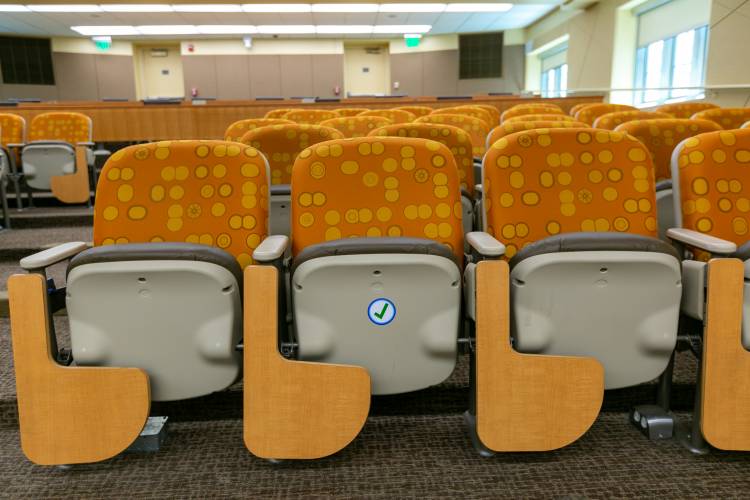
Facilities reconfigured classrooms to meet social distancing standards.
“Even though these meetings will be online, we anticipate that they will be useful for both the faculty and students, to get to see each other’s faces and just to make that direct connection that is less feasible this year given the logistical constraints,” Fitzsimons said.
THEATER STUDIES
A traditional Theater Studies mainstage course (THEATRST 350) would provide students the chance to participate in the department’s major production for the semester. But this fall, the students will experience a slightly different path, as the class responds both to the COVID pandemic and to the current racial justice movement.
The course will be hybrid, taught both online and in person, with a final performance presented for three nights to a remote audience. Department Chair Torry Bend will teach the course, with JaMeeka Holloway-Burrell, a leader of Black theater in the Triangle, taking the helm as guest director.
The class structure will become an elongated form of table work, where students read through the play and spend more time analyzing and discussing such things as themes, characters, and historical contexts—and students will still be required to participate in the play.
Guest experts and historians will periodically join the class to help students consider their own experiences of microaggressions, perceptions, and stereotypes. The work done during the first half of the class will allow students to draw on personal experiences, as well as the experiences of their classmates, to perform the final production.
“With a virtual performance and less focus on larger production elements, students will be given more time to research and investigate the play and its themes,” said Bend. “It’s a perfect theatrical experience for anyone new to theater.”
Duke communicators Andrew Park, Kirsten Khire, Van Giles, Steve Hartsoe, Margo Lakin, Kathryn Kennedy, Michael Evans, Ken Kingery, Elizabeth Richardson, Ruth Eckles and Cara August contributed to this story.
READ MORE
Duke Physician Assistant Program Adapts to Changes During COVID-19
SHARE THIS STORY
- Share this story on facebook
- Share this story on twitter
- Share this story on reddit
- Share this story on linkedin
- Get this story's permalink
- Print this story
© 2020 University Communications
614 Chapel Drive, Box 90563, Durham, NC 27708-0563
(919) 684-2823
PUBLISHED JULY 22, 2020 IN ATHLETICS , MEDICINE , RESEARCH
HOW VISION TRAINING CAN TURN THOSE GROUND BALLS INTO LINE DRIVES
Your News
Working@DukeView All SeriesView All Active TagsView Full Tag ListUniversity Statements
News Topics
AllAcademicsResearchArtsMedicine
Resources
About UsCampus Communication OfficesResources for News MediaSubscribe to the Duke News SourceContact UsDuke University Homepage
Social
www.facebook.comwww.twitter.comwww.instagram.comwww.youtube.com
© Copyright 2020 Duke University. All rights reserved.


